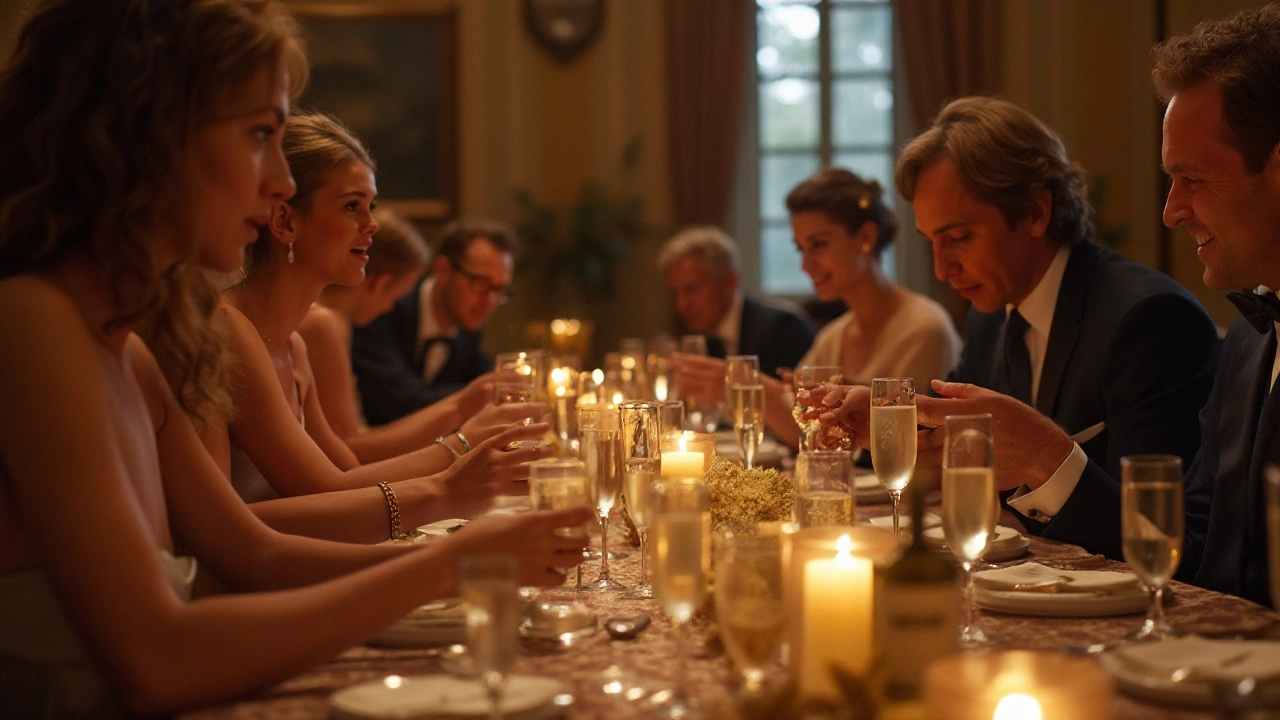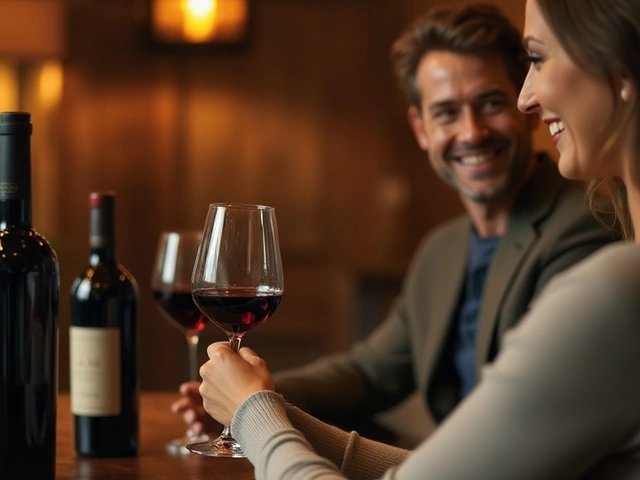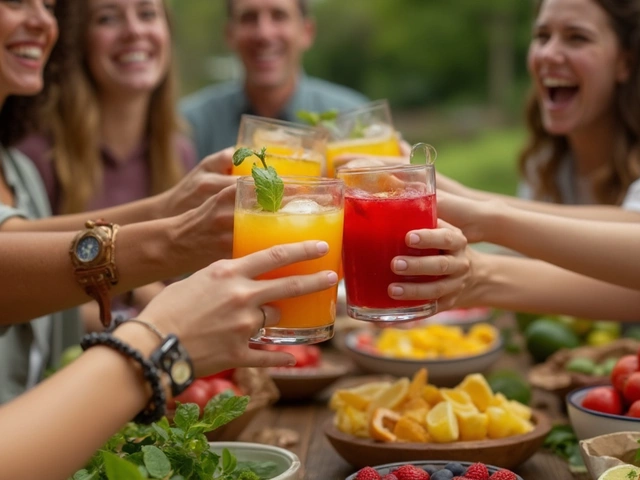Embarking on a champagne tasting adventure opens a world of effervescent delights and sophisticated flavors. Whether you're hosting an intimate gathering or attending a formal tasting event, understanding the nuances of champagne can elevate your experience. This guide will walk you through the essentials, from how to properly prepare for the tasting to uncovering the remarkable variety within a single glass.
Champagne is not just any sparkling wine; it's a symbol of luxury and celebration. With roots deeply embedded in history, each bottle brings a story that waits to be explored. As you sip and savor, you'll find that every bubble has something unique to offer, from its aroma to its texture.
- Understanding Champagne
- Preparing for the Tasting
- Serving Techniques
- Tasting Process
- Exploring Varieties
Understanding Champagne
Delving into the world of champagne is like opening a treasure chest of history and flavors waiting to be discovered. Originating from the Champagne region of France, this sparkling wine is steeped in tradition and is bound by strict regulations to preserve its authenticity and quality. The unique climate, chalky soil, and meticulous production methods all contribute to why champagne stands out in the realm of sparkling wines. At its core, champagne is made using specific grape varieties: Pinot Noir, Pinot Meunier, and Chardonnay. These varietals are blended to create the distinct flavor profile that champagne enthusiasts worldwide adore. The process known as 'Méthode Champenoise' or traditional method is what grants champagne its characteristic effervescence and structure. This method involves two fermentation stages, with the second occurring in the bottle, allowing the wine to develop its signature bubbles and complexity.
Intriguingly, the historical significance of champagne can be traced back to royal courts and grand celebrations, where it was served as an emblem of prestige and joy. In our modern times, the pop of a champagne cork continues to symbolize celebrations, from weddings to New Year's Eve. Throughout its long-standing history, champagne has been revered not only for its taste but also for the art and skill involved in production. French regulations require that all production processes occur within the Champagne region to maintain the Appellation d'Origine Contrôlée (AOC) designation. This guarantees that every bottle labeled as champagne adheres to the stringent standards that define its unique characteristics.
The allure of champagne also lies in its diversity; there are several types based on sweetness levels - Brut, Extra Dry, Sec, Demi-Sec, and Doux. Each has its place in the celebration spectrum, catering to various tastes and occasions. Whether you prefer the dryness of a Brut or the sweetness of a Demi-Sec, the key is finding which suits your palate. The intricate blend of science and artistry is what makes champagne tasting such a rich experience, offering a delightful journey through diverse notes and aromas. As the legendary cellar master Pierre-Emmanuel Taittinger once said, "Champagne is the wine of civilization, par excellence, it embodies generosity and beauty."
Preparing for the Tasting
To truly enjoy a champagne tasting, setting the right stage is crucial. Start by choosing a location that has a controlled temperature, ideally between 50 to 59 degrees Fahrenheit, as champagne reveals its flavors best at these cool levels. Lighting also plays a vital role; natural daylight allows you to observe the hue and the brilliance of the bubbles more accurately, so consider a room with ample sunlight or soft lighting if indoors.
Glassware matters in champagne tasting. Use a clear, tulip-shaped glass rather than the classic flute. The funnel shape of a tulip glass not only showcases the rise of the bubbles but also concentrates the aromas for a fuller experience. Ensure each glass is impeccably clean, free from odor or residue, which can otherwise detract from the champagne's fresh scent.
Assembling Your Selection
When selecting the bottles for a tasting event, diversity is key. A typical champagne tasting lineup includes three to five varieties, ranging from brut to rosé. This array allows you to traverse the spectrum of styles and tastes offered by different producers. For a special touch, you might introduce a vintage option. Aged champagne brings complexities that challenge the palate in delightful ways.
Some hosts prefer blind tastings, where each bottle is wrapped to obscure the label. This approach enables an honest evaluation of each champagne without bias.
"An unbiased palate can unveil nuances that often align with personal preference rather than dominant branding," notes renowned sommelier James Arthur.
Planning a tasting journey doesn't end at the bottle. Presentation and pairings extract more from the experience. Although champagne is a standout solo, subtle food accompaniments can enhance the tasting. Think of mild cheeses, nuts, or delicate seafood like shrimp or oysters, serving them on a neutral platter to avoid overshadowing the main attraction.
Details Matter: The Finishing Touches
Finally, set the ambiance with complementary elements that engage more senses. Choose background music that is soothing, ensuring it doesn't interfere with the conversation. Arrange seating to encourage dialogue and exchange, making everyone feel part of the experience rather than spectating. Seasoned hosts ensure each guest has a tasting sheet, a simple form to jot down notes, score each glass, or merely collect thoughts about the aromas and flavors experienced.
Ultimately, champagne tasting is about savoring life's cast of elegance sip by sip. So when preparing, remember that every detail—from glass to music—contributes to a fuller, more satisfying understanding of what makes each bottle unique.

Serving Techniques
When it comes to enjoying a refreshing glass of champagne, the way it is served plays a crucial role in revealing its true character. From the selection of the glassware to the temperature, each step in the serving process can impact the tasting experience. Choosing the right glass is essential, and the choice often lies between the flute and the tulip-shaped glass. Many aficionados prefer the tulip as it allows the aroma to concentrate better, enhancing the nose, whereas the flute is known for preserving the bubbles and highlighting the visual appeal of the bubbly drinks. Both options have their merits, yet the key is to ensure the glasses are spotless, free of any lingering detergent residues, which may interfere with the champagne tasting.
Temperature is another factor that can elevate your champagne experience. Serving champagne too cold can mute its flavors, while serving it too warm can overwhelm the palate with alcohol. The ideal temperature is usually around 8-10°C (46-50°F), achieved by placing the bottle in a bucket filled with ice and water for about 20 minutes. This simple action preserves the delicate balance of flavors and maintains a refreshing sensation. It's important to resist the temptation of placing the bottle directly in the freezer, as this could damage both the wine quality and the bottle itself.
Opening a bottle of champagne is an art in itself, combined with a dash of performance. The famous 'pop' is not necessary and, for some, is even frowned upon as it may cause the wine to lose its effervescence too quickly. Instead, what you want is a gentle 'hiss'. Start by removing the foil, then untwist the wire cage without removing it, keeping a thumb over the cork. With a firm hold on the cork and the base of the bottle, turn the bottle slowly while allowing the cork to ease out gently. If you're attentive, you'll hear a soft 'sigh' rather than a loud explosion. Emile Peynaud, the renowned wine scientist and educator, once said,
'Champagne, left gloriously undisturbed, speaks through its pages of bubbles.'
When it comes to pouring your champagne, the technique can influence the bubbles' longevity and texture. Gently tilt the glass on a slight angle and pour the wine slowly down the side, letting it gently cascade up the glass. This approach minimizes foam and preserves the wine's effervescence. Filling the glass one-third full allows room for swirling and improves aromatic release, essential for discerning the precise bouquet of your champagne tasting. To savor champagne like a pro, remember that patience and precision are key. Each step is an opportunity to enhance the experience, ensuring that each glass is a celebration in itself.
Tasting Process
The tasting process is an intricate dance of the senses, a journey that takes you from the first unruly pop to the last lingering note on your palate. When you pour a flute of champagne, begin by admiring its appearance. Hold your glass against a pale backdrop and watch how the light refracts through the stream of bubbles. This effervescence is not only a visual delight but also critical to the champagne’s texture. Notice the size of the bubbles and the strands they form; smaller bubbles often indicate a higher-quality champagne, creating a creamy mouthfeel that enhances the tasting experience.
After visual assessment, inhaling the aroma is where the real adventure begins. Gently swirl your glass to release the bouquet and bring it to your nose. A quality champagne releases a range of odors, from citrusy notes to aromas reminiscent of freshly baked bread or almonds. This complexity is a testament to the painstaking art involved in champagne-making. Embrace each scent as it transports you to the French countryside where these grapes thrived. Wine experts often refer to this step as the precursor to the tasting, setting the stage for what’s to come.
Now the moment you’ve anticipated: the tasting itself. Take a small sip, allowing the wine to coat your tongue. Notice the flavors intensifying as the drink warms slightly in your mouth. From the front of your tongue to the back, each area picks up different notes—fruity hints of apricot, the crispness of autumn apples, or even the subtle tang of red berries. Remember that champagne is more than just a sparkling wine—it's a symphony of flavors that dances on your taste buds, rooted in history and tradition.
As you sip, pay attention to the texture molded by those earlier bubbles you saw. A high-quality champagne will feel smooth and elegant, its bubbles working harmoniously to create a satisfying mouthfeel. The aftertaste, or finish, is the final act in this sensory performance. A long finish with pleasing flavors means the champagne leaves an enduring impression, inviting you to reflect on the journey each sip provided.
“Champagne is one of the elegant extras in life.” — Charles Dickens
Compare this experience with your previous tastings. Each champagne tells its own story, influenced by its unique production process and terroir. Whether you’re tasting a brut, extra brut, or rosé, each variety offers a different narrative waiting to be explored. Understanding and describing these subtleties can deepen your appreciation for this effervescent drink. To record your tasting notes, consider maintaining a tasting journal—an invaluable tool for reflecting on your preferences and growth as a wine enthusiast.
The art of champagne tasting is both scientific and poetic. By acknowledging each phase of the process from appearance to finish, you embrace the liquid history contained within every bottle, crafted through centuries of tradition and evolution. Every pour is a new chapter, every taste a deep dive into the world of champagne and the unparalleled experiences it holds.

Exploring Varieties
The world of Champagne tasting is akin to stepping into a gallery of bubbles, where each style offers a unique perspective on this beloved sparkling wine. The diversity begins at the very heart of Champagne production, with the three primary grape varieties—Chardonnay, Pinot Noir, and Pinot Meunier. Chardonnay, known for its crispness and elegance, forms the backbone of many exquisite bubbles. Pinot Noir adds body and structure, weaving in notes of red fruits and complexity, while Pinot Meunier lends a fruitier, softer profile that is often underappreciated but cherished by those in the know.
In Champagne, the interplay of these grapes creates a wide range of styles. Blanc de Blancs, made entirely from Chardonnay, offers a light, fresh and floral experience, often described as a pure expression of finesse. On the other hand, Blanc de Noirs, crafted solely from Pinot Noir or Pinot Meunier, presents a more robust and full-bodied character, with flavors reminiscent of red berries and earthiness. Each sip of these reds in disguise unravels layers of nostalgia, often surprising even the most seasoned palates with its depth.
Bubbly drinks are not exclusively white or rose-colored. Designations like Brut, Extra Brut, and Demi-Sec refer to the sweetness level in a bottle. Brut, the driest, is what most think of when picturing Champagne. It is often the go-to choice for pairing with foods, as it balances acidity and sugars seamlessly. But explore a little further, and you might discover the seductive sweetness of a Demi-Sec paired perfectly with desserts or spicy dishes. In this realm, Champagne isn’t just a celebratory drink, but a versatile companion for every culinary adventure.
“Champagne is one of the elegant extras in life.” – Charles Dickens
The geographical diversity within the Champagne region itself also plays a pivotal role in the variety offered. Different villages and crus impart unique characteristics to their Champagnes. For instance, Montagne de Reims is renowned for Pinot Noir’s intensity, while the Côte des Blancs is the chosen land for the finest Chardonnay. Discovering the terroir-inspired nuances in these wines broadens not only your palate but your understanding of why bubbly drinks are so richly revered. As you dive into this sparkling journey, each glass becomes not just a tasting but an exploration of winemaking art.
Let’s not forget the Houses, whose names have become synonymous with excellence in wine tasting circles around the globe. Whether it’s the delicate style of a Taittinger or the robust, full-bodied character of a Bollinger, each House offers not merely a drink but an invitation to become part of a heritage and passion that can often span centuries. Each bottle is bottled sunshine riding waves of tradition and innovation - a true testament to the art of crafting the world’s finest sparkling wine.


